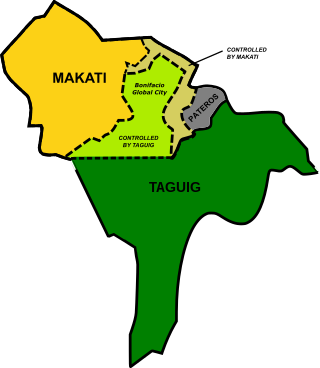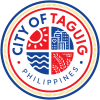
"Lupang Hinirang", originally titled in Spanish as "Marcha Nacional Filipina", and commonly and informally known by its incipit "Bayang Magiliw", is the national anthem of the Philippines. Its music was composed in 1898 by Julián Felipe, and the lyrics were adopted from the Spanish poem "Filipinas", written by José Palma in 1899.

Parañaque, officially the City ofParañaque, is a first class highly urbanized city in the National Capital Region of the Philippines. According to the 2020 census, it has a population of 689,992 people.

Muntinlupa, officially the City of Muntinlupa, is a 1st class highly urbanized city in the National Capital Region of the Philippines. According to the 2020 census, it has a population of 543,445 people.

Makati, officially the City of Makati, is a highly urbanized city in the National Capital Region of the Philippines, known for being one of the leading financial centers in the country. As of 2013, the city has the highest concentration of multinational and local corporations in the Philippines. Major banks, corporations, department stores as well as foreign embassies are based in Makati. Makati is also known for being a major cultural and entertainment hub in Metro Manila. According to the 2020 census, it had a population of 629,616 people, making it as the 47th most populous city in the country and ranked as the 43rd most densely populated city in the world with 19,336 inhabitants per square kilometer or 50,080 inhabitants per square mile. In 2023, the 10 Embo barangays were removed from Makati's jurisdiction as a result of the Makati–Taguig boundary dispute ruling, resulting in a reduction of the city's population to about 292,743. The daytime population of the city is estimated to be more than three million during a typical working day because of the large number of people who go to the city to work, shop, and do business.

Pateros, officially the Municipality of Pateros, is the lone municipality of Metro Manila, Philippines. According to the 2020 census, it has a population of 65,227 people.

Taguig, officially the City of Taguig, is a coastal city located in eastern shores of Metro Manila. It is the fifth-most populous city in the Philippines with a population of 1.2 million people. The city is one of the Philippines' cultural, financial, high-tech, entertainment and media centers with significant influence on commerce, health care, research, technology, education, politics, tourism, dining, art, fashion, and sports. Taguig is also an important center for the country's international diplomacy, hosting several embassies. The city also home to the headquarters of several major multinational corporations. Taguig has the fourth largest skyline in the Philippines, with 289 high-rises, 80 of which exceed 100 m (328 ft).

Calamba, officially the City of Calamba, is a 1st class component city in the province of Laguna, Philippines. According to the 2020 census, it has a population of 539,671 people making it the largest city in the province.

Sinait, officially the Municipality of Sinait, is a 3rd class municipality in the province of Ilocos Sur, Philippines. According to the 2020 census, it has a population of 25,998 people.
Justino 'Tining' R. Romea was a Filipino composer, playwright, director, musical arranger, poet, and journalist. He composed the Bohol Hymn — later translated to “Awit sa Bohol” which became the official hymn of the Province of Bohol, Philippines. He also composed “Dalaga sa Baybayon” — one of the many theme songs he wrote for his stage plays — and the beloved love song “Ako Kang Paabuton” which he dedicated to his wife Jesusa Dalugdug Romea with whom he has eight children. J. Ning Romea composed the University of Bohol Hymn commissioned by the Tirol family. His Bohol Chronicle Sunday columns marked by deep, sensitive — at times good-humored — observation of Filipino culture, were a mainstay for many years.
The Marangál na Dalit ng̃ Katagalugan is a song of the Philippine Revolution composed in November 1896 by Julio Nakpil at the request of Andres Bonifacio as the anthem of the revolutionary Tagalog Republic. However, this nascent revolutionary government was displaced and superseded by a succession of revolutionary governments headed by Emilio Aguinaldo and the composition known today as Lupang Hinirang became the national anthem of the Republic of the Philippines.

Pilar Manalo Danao also known as Ka Pilar, Manang and PMD, was the eldest daughter of Felix Y. Manalo and the first Head Choir Director of the Iglesia ni Cristo (INC) from 1942 until her death in 1987. She was instrumental in the creation of hymns for INC; she is the sole lyricist of the church’s Tagalog hymnal, Ang Himnario ng Iglesia ni Cristo. The hymnal originally contained 220 songs, and its first publication in 1937 bears her name and initials imprinted on hymnals and musical scores (Tagalog) for the choir.

The Our Lady of Mount Carmel Parish, also known as Nuestra Señora del Carmen Parish is a Roman Catholic church situated in Km. 38, Barangay Pulong Buhangin, Santa Maria, in the province of Bulacan, Philippines. It is under the jurisdiction of the Diocese of Malolos and within the Vicariate of Santa Maria.

The local city governments of Makati and Taguig of the Philippines were involved in a territorial dispute. The cities claimed jurisdiction over Fort Bonifacio, which includes the financial district of Bonifacio Global City (BGC) and Enlisted Men’s Barrios (Embo) barangays.

Maria Sheilah "Honey" Honrado Lacuna-Pangan is a Filipina physician and politician who has served as the Mayor of Manila since 2022. The first woman to serve as the city's Mayor, Lacuna previously served as the city's Vice Mayor from 2016 to 2022, as Officer-In-Charge of the Manila Department of Social Welfare from 2013 to 2015, and as a member of the Manila City Council from 2004 to 2013. She is a child of the former Vice Mayor Danilo Lacuna.

Local elections were held in Marikina on May 9, 2022, as part of the Philippine general election. Held concurrently with the national elections, the electorate voted to elect a mayor, a vice mayor, sixteen city council members, and two district representatives to congress. Those elected took their respective offices on June 30, 2022, for a three-year-long term.

Local elections were held in Pateros on May 9, 2022, as a part of the Philippine general election. The voters elected local elective posts in the municipality: the mayor, vice mayor, district representative of Pateros-Taguig, and councilors, six in each of the city's two legislative districts.

Ususan is one of the 38 barangays of Taguig, Metro Manila, Philippines.
Calzada, also known as Calzada Tipas, is one of the 38 barangays of Taguig, Metro Manila in the Philippines.
Local elections are scheduled to be held in Taguig on May 12, 2025, as part of the 2025 Philippine general election. The electorate will elect a mayor, a vice mayor, sixteen members of the Taguig City Council, and two district representatives to the House of Representatives of the Philippines. The officials elected in the election will assume their respective offices on June 30, 2025, for a three-year-long term.

The Taguig City Council is the legislature of Taguig City, Philippines. The legislative body is composed of 18 councilors, with 16 councilors elected from Taguig City's two councilor districts and two elected from the ranks of barangay (neighborhood) chairmen and the Sangguniang Kabataan. The council's presiding officer is the vice-mayor. The council is responsible for creating laws and ordinances under the jurisdiction of Taguig City. Although the mayor can veto proposed bills, the council can override the veto with a two-thirds supermajority.
















